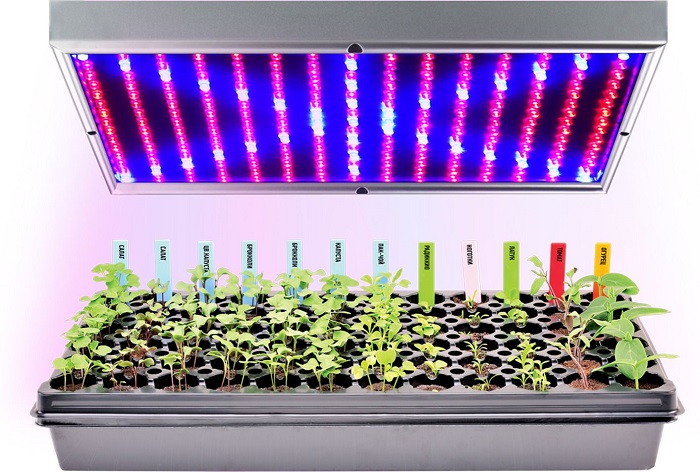Every year, energy equipment becomes more expensive. Therefore, production efficiency is a key parameter for many plant growers. LED bulbs use electrical energy much more efficiently compared to traditional halogen or fluorescent bulbs. Approximately, an LED lamp uses 60-80% less electricity than a standard incandescent bulb.
Long service life
While the initial cost of LED bulbs may be higher, they last much longer. The average lifespan of an LED bulb is 25,000-50,000 hours, compared to 1,000 hours for conventional incandescent bulbs. This can significantly reduce the cost of replacing bulbs.
Spectrum Selection
Plants react to different spectra of light in different ways. For example, the blue spectrum promotes growth, while the red spectrum promotes flowering. LEDs can be set to emit a specific spectrum of light, making them an ideal choice for creating optimal conditions for plants.
Thermal safety
Overheating is one of the main problems growers face when using traditional bulbs. LED lamps produce less heat, which reduces the risk of overheating of plants.
Flexibility in the installation
Modern LED systems are highly flexible. They can be installed both vertically and horizontally, as well as integrated into automated control systems.
Increased plant productivity
Studies have shown that plants that receive light from LED lights often grow faster and produce higher yields.
Ecology
In a world where environmental issues are becoming increasingly relevant, it is important to consider the environmental impact of technology. LED lamps do not contain harmful substances and have less impact on the environment compared to other types of lighting.
Diode layouts in phyto lamps
- Red & Blue Diodes
- Purpose: The combination of red and blue diodes is often used to stimulate vegetative growth and flowering of plants. The blue diode promotes the growth and development of the root system, while the red diode stimulates flowering and fruiting.
- Application: Ideal for hydroponics, greenhouses, as well as for house plants during periods of low light.
- White & Red Diodes
- Purpose: The combination of white and red diodes provides a wide spectrum of light that reflects natural sunlight. The white diode ensures the overall growth of the plant, while the red diode stimulates flowering.
- Application: This arrangement is well suited for all-season plant cultivation at home or in the office.
- Full Spectrum Diodes
- Purpose: Full-spectrum lamps contain a combination of diodes of different colors that try to mimic natural sunlight as close as possible. They provide an optimal spectrum for all stages of plant growth.
- Application: Ideal for professional growers and those who want to get the best yield from their plants.
These diode layouts in phyto lamps are selected depending on the specific needs of the plants and growing conditions. It is important to understand the needs of your plants in order to choose the most suitable lamp for them.
Light-emitting diodes (LEDs) have become a popular solution for plant lighting mainly due to their efficiency and ability to fine-tune the spectrum. Here are some scientific arguments supporting the benefits of LED lighting for plants compared to older lighting systems:
- Accurate spectrum for photosynthesis: Plants use light primarily in the blue (about 400-500 nm) and red (about 600-700 nm) spectra for photosynthesis. LED bulbs can be designed to produce these spectrums, maximizing lighting efficiency.
- Energy efficiency: According to research, LED bulbs convert significantly more electricity into light than most traditional light sources, such as incandescent bulbs or fluorescent bulbs.
- Less thermal radiation: Traditional light sources can generate a lot of heat, which can cause plants to overheat or require additional cooling. LED bulbs generate less heat, making them ideal for controlled growing environments.
- Long lifespan: LED lamps typically have a longer lifespan than traditional fixtures. This reduces the need for frequent replacements and increases the return on investment.
- Reduced stress for plants: Some studies have shown that certain light spectrums can help plants better cope with stress, such as dryness or high temperatures.
- Wider range of illumination: Unlike many traditional fixtures, LED can provide a wide range of light, including UV and infrared radiation, which can affect plant growth and development.
These and other studies confirm that LED lighting systems provide many benefits for growing plants, especially in controlled environments such as hydroponics, vertical agriculture, and greenhouses.
Modern LED lighting technologies open up new horizons of possibilities for agriculture and plant lovers. The use of LED lamps in the field of phytolighting not only allows you to effectively simulate the natural spectrum of sunlight, but also optimizes it for the specific needs of plants. Whether you have a commercial greenhouse or just want to light up your houseplants in the fall and winter, LED technology provides the best opportunities for optimal results.












Оставить коммент.